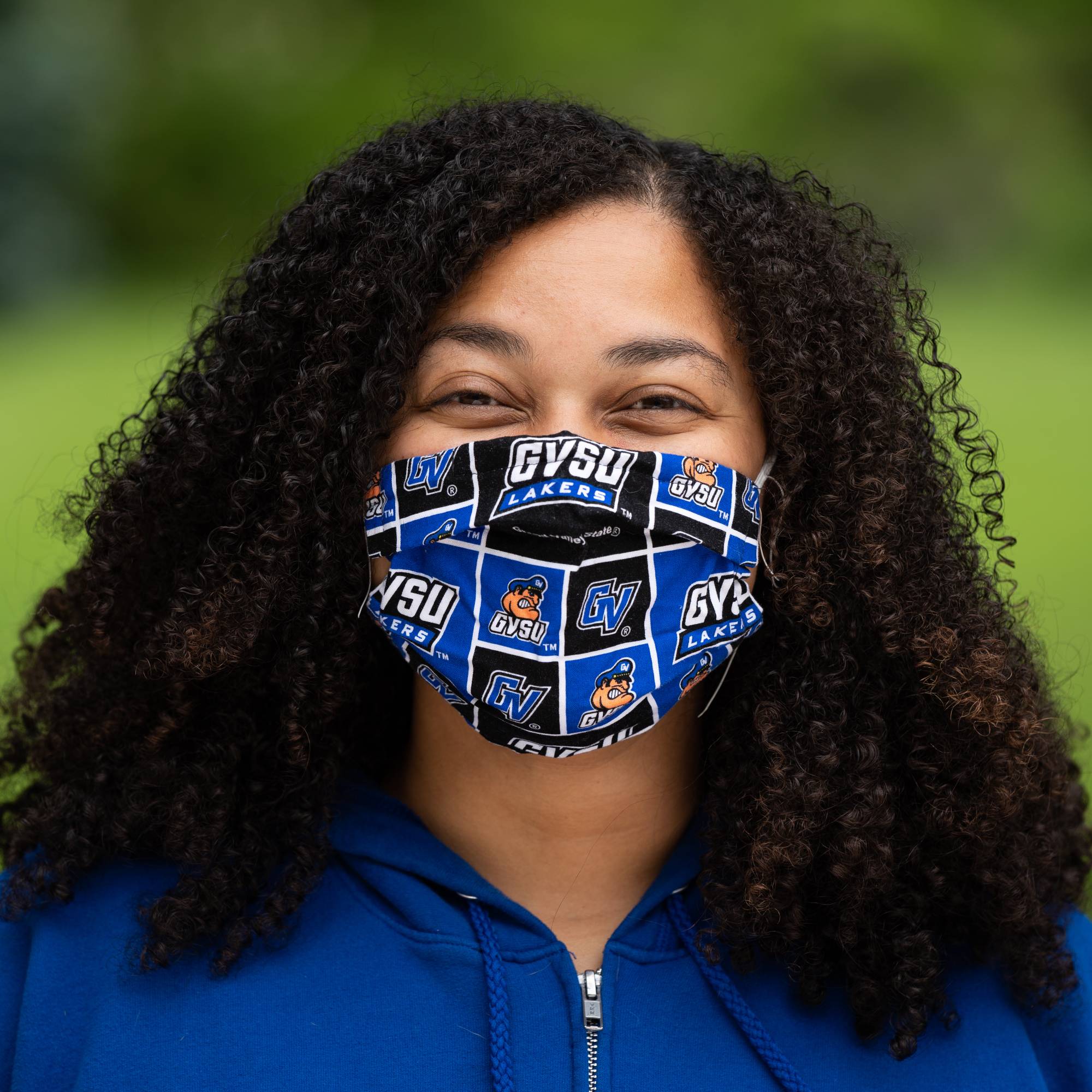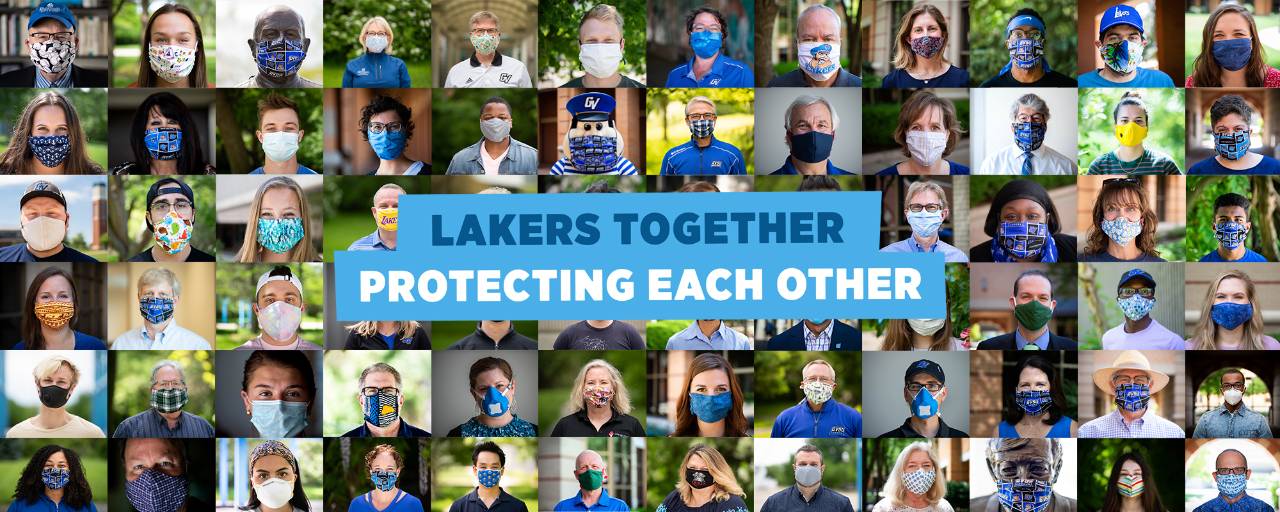Face Covering Policy
Updated March 14,2024
Grand Valley moved its COVID alert level to Level 0 This means that face masks will be optional in all campus locations, including classrooms and other academic spaces.
Faculty members can request their students wear face masks in class but cannot make it a requirement. There still may be unique situations where face masks are required, such as those regulated by the government.
We understand this will be a significant change to what we are accustomed to. Some members of the campus community will choose to continue to wear face masks, and they should be supported by all Lakers for doing so. Faculty and staff can require masks to be worn in their private offices.

Grand Valley has obtained 10,000 KN95 masks and 10,000 medical procedure (ASTM 1) masks for campus community members who wish to wear these. Departments can order these masks through the normal PPE requisition process through Facilities Services. More masks are on order and expected soon. We will do everything possible to ensure adequate mask availability despite supply chain pressure.
Students can pick up these types of masks at the following locations. Supplies will be replenished each weekday.
Allendale Campus: Recreation Center, Mary Idema Pew Library, Kirkhof Center;
Pew Grand Rapids Campus: Eberhard Center, parking services desk.
Nearly 200,000 non-medical three-ply disposable masks continue to be available (these are the masks that have been supplied since the pandemic began). For most people on campus, these masks are sufficient, as are the washable cloth masks (two-ply).
Important mask details:
• A KN95 improperly worn is not safer than a cloth mask worn properly.
• A disposable three-ply mask worn with a two-ply cloth mask is equivalent to a KN95 mask for protection.
• Some people will not tolerate a KN95 mask and find it difficult to breathe, and might relax their mask. They may find the double-mask option more tolerable.
• A clean KN95 that is properly cared for should last for five days.
- Those unable to wear a face covering due to a medical condition should contact Disability Support Resources (DSR).
- Students, faculty and staff with weakened immune systems should discuss their activities and precautions they need to take to prevent COVID-19 with their health care providers. Currently, the CDC recommends continued masking and physical distancing for individuals with weakened immune systems.
- Students, faculty and staff are encouraged to wear masks or avoid crowded, outdoor events, like a live performance, parade, or sports event that might carry higher risk of COVID-19 transmission especially among unvaccinated individuals.
- Faculty, staff and students are responsible for laundering their face coverings and properly disposing of one-time use masks
- Compliance is facilitated primarily through proactive, ongoing education, communication, modeling and reduction of barriers.
Face covering FAQ
Yes, masks have proven to be very effective in preventing the spread of the COVID-19 virus. The U.S. Center for Disease Control (CDC) references over 90 studies all showing the effectiveness of mask-wearing to prevent the spread of viruses (SARS, COVID-19, Influenza, etc.). Mask wearing has demonstrated effectiveness with all the variants of concern for COVID-19. For more information: https://www.cdc.gov/coronavirus/2019-ncov/science/science-briefs/masking-science-sars-cov2.html.
The primary purpose of masks is to prevent virus-laden aerosols of exhaled air from being expelled into the environment. If everyone in an inside area is wearing a mask correctly, virus transmission becomes difficult. Two layers of tightly woven cloth have demonstrated up to a 50% - 80% decrease in fine droplets and particles. This is similar to a three-layer medical procedure mask. For more information: https://www.cdc.gov/coronavirus/2019-ncov/science/science-briefs/masking-science-sars-cov2.html and https://www.nature.com/articles/s41591-020-0843-2. NOTE: Do not wear any type of mask with exhalation valves as this defeats the intended purpose of the mask.
Mask effectiveness, for the wearer, is dependent on two criteria, filter efficiency and mask fit. The filter efficiency of two-layer cloth masks is 50% for particles of 1 micron and more efficient at larger aerosol sizes. Three-layer medical procedure masks are 60 - 80% efficient in capturing aerosols. KN95 and N95 masks have five layers of filters and efficiencies of 85% - 95%. Double masking, such as a cloth mask (two-layer) over a medical procedure mask (three-layer) or two medical procedure masks can approach (75% to 90+%) filter efficiencies of N-95 masks. For more information: https://www.cdc.gov/coronavirus/2019-ncov/science/science-briefs/masking-science-sars-cov2.html, https://aaqr.org/articles/aaqr-21-05-oa-0117, and https://www.cdc.gov/mmwr/volumes/70/wr/mm7007e1.htm?s_cid=mm7007e1_x
The other criteria for determining mask efficacy is how well the mask fits. Having a mask that fits snugly over the nose and mouth increases the efficiency of the mask. Facial hair interferes with the fit of any mask making them less efficient. Nose wires for cloth masks, mask fitters/braces, and knotting and tucking for medical procedure masks can improve mask effectiveness. The CDC offers excellent guidance on how to properly achieve a proper fit. For more information: https://www.cdc.gov/coronavirus/2019-ncov/prevent-getting-sick/mask-fit-and-filtration.html , https://www.cdc.gov/coronavirus/2019-ncov/prevent-getting-sick/masks.html, and https://www.cdc.gov/mmwr/volumes/70/wr/mm7007e1.htm?s_cid=mm7007e1_x
Three issues decrease the efficiency of masks. Masks not worn over the nose and mouth (incorrect use). Additionally, masks not worn by everyone in a meeting or class (inconsistent use). Lastly, a mask worn with large gaps in the sides (improper fit).
The effectiveness of masks is also reduced if they are uncomfortable enough to cause constant adjustment and removal to gain relief. The more layers a mask has the more breathing is labored. Increased breathing resistance and decreased comfort and can lead to mask fatigue and decreased mask use.
Facial hair interferes with the fit of any mask making them less efficient. Those with facial hair should shave, trim their beard, or add an additional mask that closes the sides of the mask snugly against the face. For more information: https://www.cdc.gov/coronavirus/2019-ncov/prevent-getting-sick/mask-fit-and-filtration.html and https://www.cdc.gov/mmwr/volumes/70/wr/mm7007e1.htm?s_cid=mm7007e1_x
Any type of mask should be kept clean and dry. Dirty masks or wet masks should be disposed of, or if a cloth mask, laundered. Masks when not being used should be stored in a paper bag and not in a plastic bag.
Medical procedure masks and KN95s should be disposed of after 5 days of use or sooner if they become soiled or wet. For more information: https://www.cdc.gov/coronavirus/2019-ncov/prevent-getting-sick/about-face-coverings.html and https://www.osha.gov/laws-regs/regulations/standardnumber/1910/1910.504

